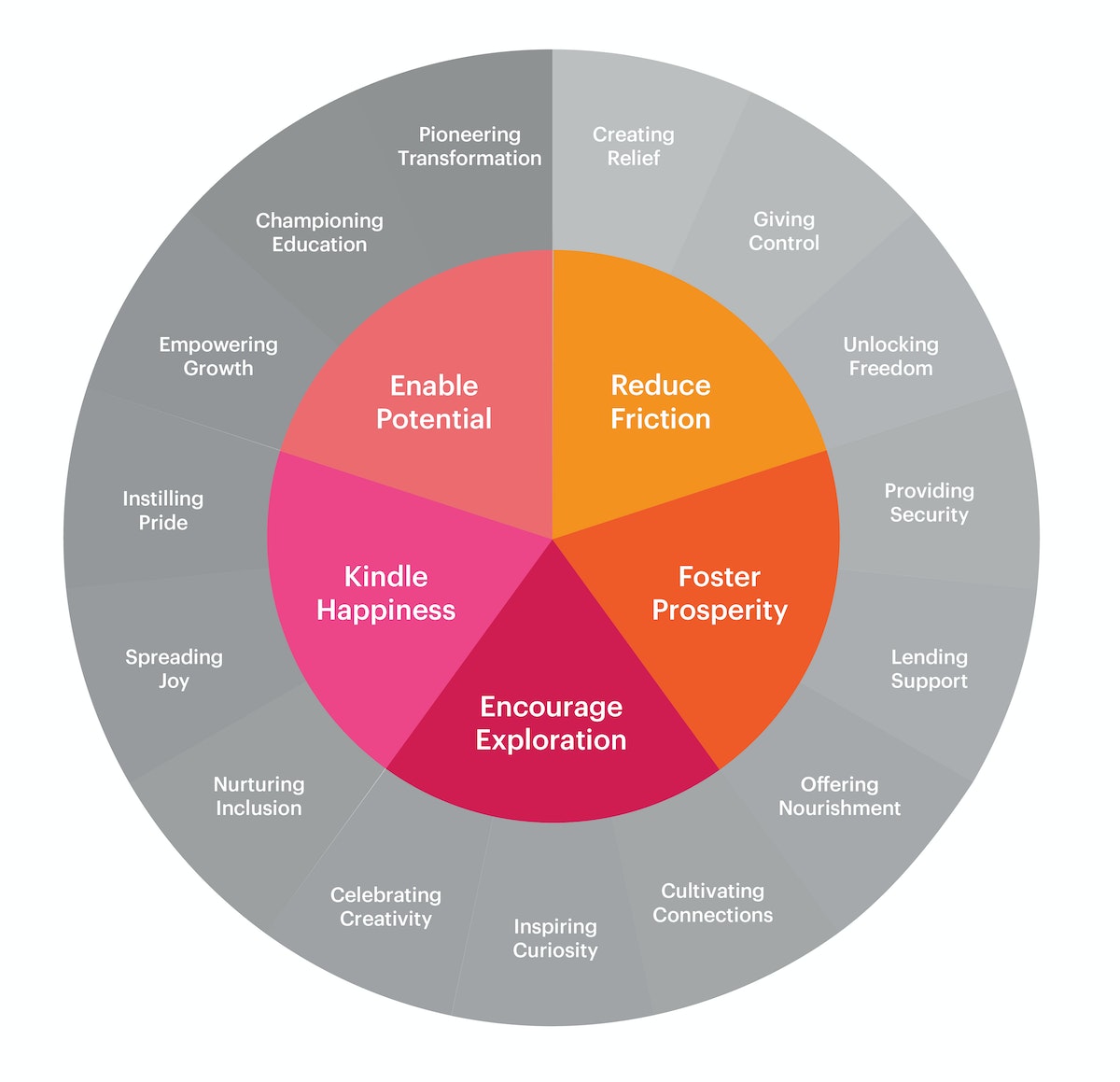Design an organization's purpose statement with this tool

If you’ve ever tried to do anything with your extended family, you know getting a bunch of people to agree on anything is hard—where to go on vacation, what to eat, who to invite to come along. Businesses face the same kind of group challenges.
This can prompt a lot of thorny questions. Where do we want to go together? What do we stand for? Beyond profit, why do we exist?
At IDEO, designers often find themselves working with companies and organizations that are looking to do just that: rally around a sense of purpose. Earlier this year, the two of us were working with the visionary CEO of a parent company who wanted his global organization to be led by purpose. He also wanted all of the business group leaders to be a part of articulating it. So we started by creating a place for everyone to start.
Inspired by Maslow’s hierarchy of needs and what motivates human satisfaction, we created a purpose framework called the Purpose Wheel. (Spoiler alert: We'll have a version of the wheel for you to download at the bottom of this post.) The idea is that groups of people working together—both large and small organizations, as well as teams and individuals—can find a sense of purpose if they’re able to first imagine various ways they might have impact on the world.
The Purpose Wheel helps the designers who are leading the way take the first step. It’s a tool to encourage generative conversations about future goals, and ultimately create a foundation that the organization’s leadership can align on before sitting down to write out the statement that answers “the why.”
Just like building a house starts with the scaffolding, the Purpose Wheel helps you engineer the intent behind the purpose statement before you start crafting the words. Though the original wheel was used in a corporate setting, these four steps will set you up for success in using it no matter how big or small your group is.
1. Start at the center
The center of the wheel suggests five ways a company or organization might have an impact on the world. Each slice answers the “Why do we exist beyond profit?” question in a different way.

Think about the company you’re working with, and ask yourself: beyond profit, why does it exist? The first step is to consider your hunch and make a prediction. Where do you think your business will land?
- We exist to Enable Potential
Creating impact by inspiring greater possibilities. (Tesla, Nike) - We exist to Reduce Friction
Creating impact by simplifying and eliminating barriers. (Google, Spotify) - We exist to Foster Prosperity
Creating impact by supporting the success of others. (Pampers, Warby Parker) - We exist to Encourage Exploration
Creating impact by championing discovery. (Airbnb, Adobe) - We exist to Kindle Happiness
Creating impact by inciting joy. (Dove, Zappos)
2. Go full circle
The idea is not to select one reason for existence and insist everyone rally around it. Instead, the goal is to imagine the company in question having impact in each of the five ways, then have conversations about what that impact might look like today—and in the future—even if some of them feel like a tight fit or a challenge.
Here are some questions to ask at this stage:
- What actions, behaviors, or experiences would have to happen in order for that statement of impact to be true?
- How might this kind of impact inspire your culture?
- How might this kind of impact change the way you make business decisions?
The wheel works best when you try all five types of impact on for size and eliminate those that may not align with your business strategy or long-term vision.
If this feels hard to nail down, we understand—purpose can be a fuzzy thing. For a tangible example, take purpose-led Patagonia and North Face, for instance. Since purpose is inextricably tied to brand, you can see how purpose can show up in the world very differently, even from two companies who might otherwise have a similar product offering.
Patagonia: We’re in the business to save our home planet.
The North Face: Pushing the limits of innovation and design, so that you can push your limits outdoors.
Looking back at the wheel, you can see how the engineering of Patagonia’s purpose statement could be enable potential, while The North Face could be encourage exploration.


3. Answer the "how" questions
Once you have alignment around the center wheel, you can move to the outer wheel. This is where you can move the conversation towards the “how”—how your business makes an impact. The outer wheel doesn’t offer a comprehensive list of hows, and there may not always be one clear answer.

However, the outer wheel is there to push your imagination and force you to consider how your company might make an impact. With it, you continue to engineer your purpose statement: We exist to (inner wheel) through (outer wheel) to impact society for the better.
4. Pressure-test it
Start to apply this to your company by putting yourself in the shoes of employees who range from top to bottom, east to west. Have conversations and ask them: what would happen if you applied this purpose framework to your work today? What would this unlock for you as an employee?

Once you’ve dug into what purpose looks like for your organization from the various angles of the wheel, you’ll be armed with lots of rich conversations and hopefully a newfound agreement on the engineering. The rest of the work happens in the writing.
In other words, you can start playing with the poetry and build on bringing your organization’s purpose to life.
Words and art



Subscribe

.svg)







